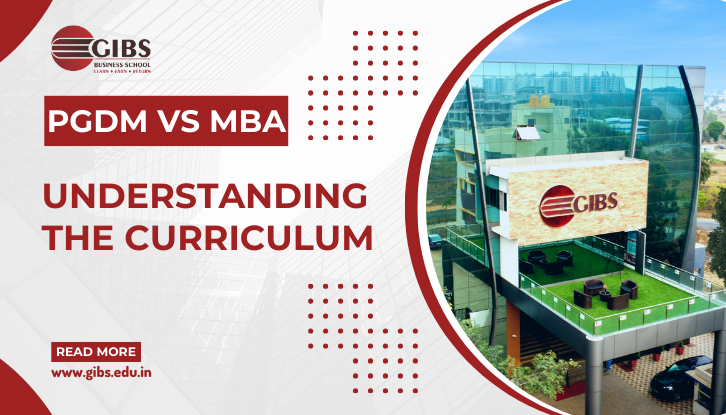Understanding the Curriculum: PGDM vs MBA
Aspiring management professionals often find themselves in a dilemma when it comes to choosing their higher education path from a Post Graduate Diploma in Management (PGDM) or a Master of Business Administration (MBA). This difference, if subtle, is crucial — a question of career path, skill acquisition, and employment. In this context, the article will analyze the curriculum of both PGDM, and MBA to understand the difference, similarity, and importance of each course in relevance to career aspirations and the detailed examination of the curriculum.
Understanding the basics: PGDM vs MBA
The Post Graduate Diploma in Management also referred to as PGDM, is a diploma course offered by autonomous data institutes that are recognized by AICTE (All India Council for Technical Education). These institutes can update course content periodically based on the current trends in the industry.
On the other hand, an MBA or Master of Business Administration is a degree program generally provided by the universities recognized by the University Grants Commission (UGC). The MBA syllabus is generally universal amongst all universities by UGC norms.
Curriculum Comparison: PGDM vs MBA
Flexibility and Customization
PGDM courses have maximum flexibility in terms of curriculum design. They frequently update the syllabi in accordance with industry trends, technological advancements, and market demands so that graduates become industry-ready. This adaptability is why PGDM programs may include courses like Digital Marketing, Business Analytics, Fintech and AI management.
MBA curricula, on the other hand, are built around a static framework with more checks from the university. Such structures require long approval processes for change in syllabus and as a result, they are not able to adapt to the fast-paced changes that come in the industry.
Practical Orientation
PGDM courses focus on the development of practical skills, with real-time assignments, internships, and industry exposure to gear up students for the actual work scenario. PGDM curriculum prioritizes this by way of live projects, case studies, mandatory industry internships, and guest lectures.
Four MBA programs emphasize management theories, frameworks, and administrative principles instead of practical exposure. Not as many practical parts in MBA courses as in PGDM.
Industry Alignment
PGDM institutes provide direct collaborations with industry leaders, corporations, and overseas universities. These partnerships help shape industry-linked curricula that promote employability and global ability.
On the other hand, MBA programs, being regulated by UGC standards, tend to provide broader and more standardized exposure to the industry and are therefore more limited in their direct industry relevance.
Well, there are some similarities between PGDM and MBA Curriculums.
Although they differ in many aspects, PGDM and MBA programs have common ground as well:
- Essential topics: Both curricula involve important domains such as finance, Marketing, Human Resources, Operations, and Strategic Management.
- Skill Building: Both programs focus on developing leadership, analytical thinking, decision-making, and problem-solving skills.
- Duration and format: Often, PGDM and MBA are two-year programs offered in four semesters or six trimesters.
Career Prospects: PGDM vs MBA
Graduates from both programs get high-paying jobs. But the career path is not always as straightforward:
Thus, organizations prefer hiring PGDM graduates for specific industry knowledge, technology-savvy, and hands-on skills. This is the reason why PGDM candidates are the most preferred candidates in various industries including IT, Marketing, Finance, Consulting, etc.
However, MBA graduates usually get placed in management roles, administration, and academia. MBA degree holders are often preferred for administrative and managerial roles in government organizations and multinational companies.
International Recognition and Education Opportunities
MBAs are also more widely accepted in job markets around the world as they are associated with universities and standardized systems of education. However, PGDMs gain worldwide recognition increasingly through tie-ups, partnerships, and accreditations from reputed international agencies such as AMBA, AACSB and EQUIS.
PGDM vs MBA: How to Choose One Among Them?
The decision of whether to pursue a PGDM or an MBA should reflect in terms of personal career objectives, industry demands, and individual preferences:
Choose PGDM if:
- You lean towards domain knowledge.
- You put a premium on practical experience, hands-on instruction, and contemporary industry skills.
- You want to be employable fast in consulting, technology, marketing, or finance.
Choose MBA if:
- You are suited for an organized and conventional system of education.
- You go for administrative roles, jobs in government, or academic positions.”
- You are high on a global degree brand.
PGDM vs MBA: Final Thoughts
While both PGDM and MBA programs are highly regarded, they cater to different career goals and learning styles. In the end, the decision to choose PGDM or MBA should come down to a candidate’s individual career goals, the sector they want to work in, their preferred learning method, and whether or not the program is offered by a PGDM or MBA institution.
GIBS Business School, Bangalore — Spotlight
If you’re considering the Top 10 MBA/PGDM Colleges in Bangalore, GIBS Business School offers extraordinary value. A pioneer of the experimental curriculum in India, GIBS works with corporates and innovators to design experiential PGDM programs that offer students one-of-a-kind practical exposure in an evolving workplace. With a strong placement record, global exposure, and collaborations with leading corporates, GIBS Business School places its PGDM graduates firmly in the corporate world and is a premier institution for any aspiring management professional.

